Toyota Corolla (E170): Engine oil
With the engine at operating temperature and turned off, check the oil level on the dipstick.
■ Checking the engine oil
1 Park the vehicle on level ground. After warming up the engine and turning it off, wait more than 5 minutes for the oil to drain back into the bottom of the engine.
2 Holding a rag under the end, pull the dipstick out.
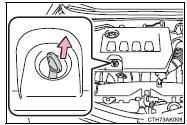
3 Wipe the dipstick clean.
4 Flat dipstick: Reinsert the dipstick fully.
4 Non-flat dipstick: Reinsert the non-flat dipstick fully with its protruding areas ( 1 in the illustration) pointing towards the engine.
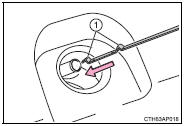
5 Holding a rag under the end, pull the dipstick out and check the oil level.
1 Low
2 Normal
3 Excessive
► Flat dipstick
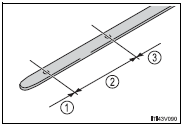
►Non-flat dipstick
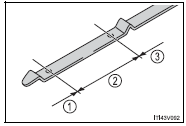
The shape of the dipstick may differ depending on the type of vehicle or engine.
6 Wipe the dipstick and reinsert it fully.
■ Adding engine oil
If the oil level is below or near the low level mark, add engine oil of the same type as that already in the engine.
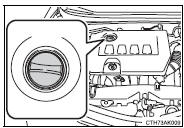
Make sure to check the oil type and prepare the items needed before adding oil.

1 Remove the oil filler cap by turning it counterclockwise.
2 Add engine oil slowly, checking the dipstick.
3 Install the oil filler cap by turning it clockwise.
■Engine oil consumption
A certain amount of engine oil will be consumed while driving. In the following situations, oil consumption may increase, and engine oil may need to be refilled in between oil maintenance intervals.
●When the engine is new, for example directly after purchasing the vehicle or after replacing the engine ●If low quality oil or oil of an inappropriate viscosity is used ●When driving at high engine speeds or with a heavy load, or when driving while accelerating or decelerating frequently ●When leaving the engine idling for a long time, or when driving frequently through heavy traffic
CAUTION
■Used engine oil
●Used engine oil contains potentially harmful contaminants which may cause skin disorders such as inflammation and skin cancer, so care should be taken to avoid prolonged and repeated contact. To remove used engine oil from your skin, wash thoroughly with soap and water.
●Dispose of used oil and filters only in a safe and acceptable manner. Do not dispose of used oil and filters in household trash, in sewers or onto the ground.
Call your Toyota dealer, service station or auto parts store for information concerning recycling or disposal.
●Do not leave used engine oil within the reach of children.
NOTICE
■To prevent serious engine damage
Check the oil level on a regular basis.
■When replacing the engine oil
●Be careful not to spill engine oil on the vehicle components.
●Avoid overfilling, or the engine could be damaged.
●Check the oil level on the dipstick every time you refill the vehicle.
●Be sure the engine oil filler cap is properly tightened.
Other materials:
Windshield wipers and washer
Operating the wiper lever
The wiper operation is selected by moving the lever as follows. When intermittent
windshield wiper operation is selected, the wiper interval can be also adjusted.
1 Intermittent windshield wiper operation
2 Low speed windshield wiper operation
3 High speed windshield ...
If the electronic key does not
operate properly (vehicles with a
smart key system)
If communication between
the electronic key and vehicle
is interrupted or the electronic key cannot
be used because the battery
is depleted, the smart key
system and wireless remote
control cannot be used. In
such cases, the doors can
be opened and the engine
can be started by following
the procedur ...
Circuit description
This circuit turns on the magnetic clutch inside the actuator during cruise
control operation according to the
signal from the ecu. If a malfunction occurs in the actuator or speed sensor,
etc. During cruise control operation,
the rotor shaft between the motor and control plate is released.
...


